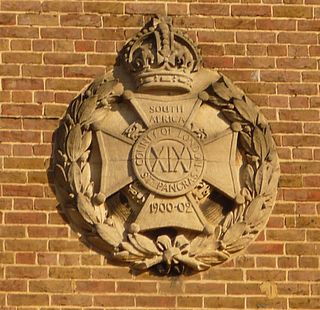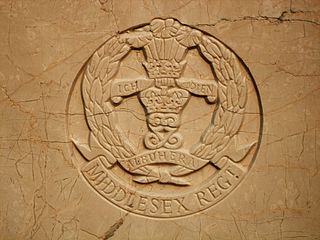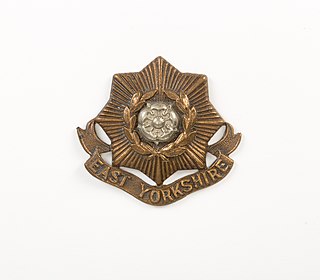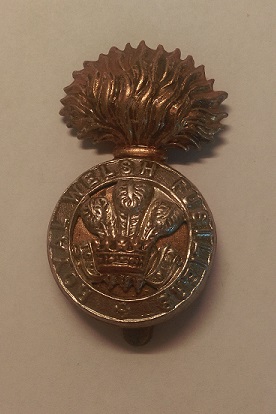The 1st Isle of Wight Rifle Volunteers, later the 8th Battalion, Hampshire Regiment, but known informally as the 'Isle of Wight Rifles', was an auxiliary unit of the British Army formed to defend the Isle of Wight after a mid-19th Century invasion scare. During World War I it fought in the Gallipoli Campaign, taking part in the calamitous attack at Suvla Bay, and later at the battles of Gaza and Megiddo in Palestine. Between the wars it was converted to coast defence artillery and served in this role on the Isle of Wight throughout World War II. One battery was sent to reinforce the garrison of Tobruk, where it was captured in 1942. Postwar the unit converted to the air defence role, then reverted to infantry, and its successors continue in today's Army Reserve.

The 140th Brigade was an infantry brigade formation of the British Army's Territorial Army (TA) that had its origins in a South London Brigade of the former Volunteer Force. It served on the Western Front in the First World War and was recreated during the Second World War where it served only in the United Kingdom as a training formation.

The 17th Battalion, The London Regiment , was a unit of Britain's Territorial Force formed in 1908 from Volunteer corps dating back to 1859. It saw considerable service on the Western Front, at Salonika and in Palestine during World War I. It served as an infantry regiment during World War II before conversion to an artillery unit in 1947 and subsequent amalgamation in 1967.

The 19th Battalion, London Regiment was a Volunteer unit of the British Army in existence from 1860 to 1961 under various titles. A detachment served in the Second Boer War and two full battalions fought in World War I, receiving the surrender of Jerusalem and crossing the Jordan among other exploits. During World War II the regiment operated as a searchlight unit and briefly as an infantry battalion, before becoming an anti-aircraft regiment in the postwar years.
The 7th Battalion, Essex Regiment was a volunteer unit of Britain's Territorial Army. First formed in the eastern suburbs of London in 1860, it served as infantry at Gallipoli and in Palestine during World War I. It later became an anti-aircraft (AA) unit of the Royal Artillery (RA), serving in North Africa and Italy during World War II.
The 6th Battalion, Essex Regiment was a volunteer unit of Britain's Territorial Army. First formed in the docks of East London in 1860, it served as infantry at Gallipoli and in Palestine during the First World War. It later formed searchlight units of the Royal Artillery (RA), serving during the Blitz.

The 9th Battalion, Middlesex Regiment was an infantry battalion of the British Army. Part of the Volunteer Force, later the Territorial Force, the battalion was part of the Middlesex Regiment and recruited from the north-western suburbs of London. It served as infantry in the Mesopotamian campaign during World War I and as an air defence regiment during and after World War II.

The Rangers was a volunteer unit of the British Army, originally formed in 1860. It provided a detachment for service in the Second Boer War, saw intensive action on the Western Front in the First World War, and served as motorised infantry during the Second World War during the campaigns in Greece and the Western Desert.
The St Giles's and St George's Bloomsbury Rifle Volunteer Corps, more familiarly known as the Bloomsbury Rifles, was a Volunteer unit of the British Army in London from 1803 to 1814 and from 1860 until 1908.
The 3rd Manchester Rifles, later the 7th Battalion, Manchester Regiment was a unit of Britain's Volunteers and Territorial Force raised in Manchester. It served at Gallipoli and on the Western Front in World War I.
The Blythswood Rifles was a Scottish Volunteer unit of the British Army. Raised in Glasgow from 1859, it later became a battalion of the Highland Light Infantry. During World War I it served at Gallipoli, in Egypt and Palestine, in Ireland, and on the Western Front. Converted into an anti-aircraft artillery regiment just before World War II, it served in The Blitz and in the Middle East during the war, and continued in the postwar Territorial Army until 1955.
The 6th Battalion, Royal Scots, was a unit of Britain's part-time Territorial Force. Beginning as a Volunteer unit formed from teetotallers in the city of Edinburgh in 1867, it later became affiliated to the Royal Scots. During World War I it served in the Senussi Campaign and on the Western Front. Postwar it was converted into a medium artillery battery.

The 5th (Cyclist) Battalion, East Yorkshire Regiment was a mobile coast defence unit of Britain's Territorial Force. It was formed in 1908 from a nucleus provided by a Volunteer battalion first raised in 1859. It carried out its defence duties along the East Coast throughout World War I and after the war it was incorporated into a unit of the new Royal Corps of Signals.

The 2nd Gloucestershire Rifle Volunteers, was a Volunteer unit of the British Army recruited in Gloucestershire from 1859. After becoming a Volunteer and later Territorial Force battalion of the Gloucestershire Regiment, it fought on the Western Front and in Italy during World War I. Its 1st Line battalion fought a last-ditch defensive action at the Piave and one of its number won a Victoria Cross in the closing weeks of the war. The 2nd Line battalion was involved in an epic rearguard action at Holnon Wood during the German spring offensive. In the early part of World War II the battalion distinguished itself at the defence of Ledringhem before being evacuated from Dunkirk. It then served as a unit of the Reconnaissance Corps with 43rd (Wessex) Infantry Division through the campaign in North West Europe. It returned to the Glosters in the postwar Territorial Army until amalgamated with other units in 1967.

The Exeter & South Devon Volunteers was the premier unit of Britain's Volunteer Force. Formed in 1852 it went on to become a battalion of the Devonshire Regiment. Both its active service battalions went to garrison India on the outbreak of the First World War, and then saw action in Mesopotamia and Palestine. In the Second World War, the battalion served in the garrison of Gibraltar. It continued in the postwar Territorial Army until it was merged with other West Country units. Its successors today serve in a reserve battalion of The Rifles.

The 5th Battalion, Devonshire Regiment, was a part-time unit of the British Army recruited in the county of Devon. It was formed in the Territorial Force in 1908 by amalgamating two existing Volunteer Battalions of the Devonshire Regiment. The battalion served in India and fought in Palestine and on the Western Front during World War I. In World War II it provided two anti-tank artillery units, which served in Tunisia, Italy and North West Europe. They were both merged into other Devonshire units in 1950.

The 6th Battalion, Royal Welch Fusiliers, was a Welsh unit of the British Army's auxiliary forces. Formed in 1908, from Volunteer units that dated back to 1860, it fought at Gallipoli), in Egypt and Palestine during World War I, and in the campaign in North West Europe during World War II. Postwar it was converted to the anti-aircraft artillery role, then reverted to infantry in 1956 after it amalgamated with a neighbouring unit.
The 1st Sussex Rifle Volunteers was a part-time unit of the British Army first raised from the county of Sussex in 1859. It later became the 6th (Cyclist) Battalion of the Royal Sussex Regiment. During World War I it served in home defence in Britain and Ireland, while its 2nd Line battalion served in India and Waziristan. It was not reformed after the war.
The 2nd Sussex Rifle Volunteers was a part-time unit of the British Army first raised from the county of Sussex in 1859. It later became the 4th Battalion, Royal Sussex Regiment. A detachment served in the Second Boer War. During the First World War, the battalion fought at Gallipoli, in Sinai and Palestine, and then in the final months of the war on the Western Front. In the Second World War, both the battalion and its duplicate served in the Battle of France and were evacuated from Dunkirk. The 4th Battalion then fought at the Second Battle of El Alamein, and served in the Middle East until the end of the war. It continued in the postwar Territorial Army until it lost its individual identity in a series of mergers from 1967.
The Brecknockshire Battalion was a Welsh unit of the British Army's auxiliary forces. First raised in 1859, it became a Volunteer Battalion of the South Wales Borderers. During World War I it served in garrison at Aden, where it was engaged in the Battle of Lahej. It was amalgamated with another battalion in the 1920s but regained its independence in time for World War II, when it served in home defence and supplied reinforcements to the forces fighting overseas. Postwar it was reformed as a light anti-aircraft regiment of the Royal Artillery and was one of the founder units of today's 104th Regiment Royal Artillery in the Army Reserve.









